Katrin Koenning is one of the winners of the Conscientious Portfolio Competition in 2016. The same year, her book, Astres Noirs (a collaboration with Sarker Protick), caused quite the stir, ending up on quite a few of the inevitable “best of” lists. I spoke with Katrin via email.
Jörg Colberg: Can you talk a bit about your background? You grew up in Germany, but now you live in Australia? And how did you come to photography?
Katrin Koenning: I was born and grew up in Germany’s Ruhr Area, once the country’s hub of industry. I went to Steiner school over there, and in my head I was going to be a painter, a singer or an astronaut. There is a history of fascination with the ‘away’ that runs through my ancestry; my grandmother was an abstract painter, my great-grandfather a singer at the Berlin opera… suggesting to me a desire to practise an act of yearning, and to create (other) worlds, if that makes sense.

Photography and I came to each other through the death of my oldest childhood friend Tobias whom I grew up with and whose mother is my godmother. Tobi died only weeks after we graduated from high school, in a plane crash above Iceland. He wanted to be a pilot and was passionate about photography. I inherited his old Minolta with thousands of strange filters and left for Iceland to allow myself to be with the loss. I was there for three months during deep winter, working in remote greenhouses. At night I would walk and walk, the only sound was of snow and I touching, the Minolta in my hand. I didn’t fully realise it then, but this thing – the walking, the camera, the thoughts and the silence – became the thing that would make me feel ok. When I returned home to Germany from Iceland and developed all those rolls of film, every single one was pitch black. Not a single picture. I understood quickly that somehow this needed to be exactly what it was; one thing in my mind, another in the world. There, not there – an interplay of presence and absence right at the ignition of my practice.
I interned with the German photography department in charge of all the former Ruhrzechen, the mines that had been turned into museums. Here I learned the darkroom. They gave me a key and I’d spend all my weekends there, alone, locked away with radio and chemicals. At that point my interest was definitely in story but I hadn’t decided on the visual just yet and so was working in print and broadcast journalism also.
In 2003, four things happened: 1) I was in a really shit place 2) I fell in love with an Australian man 3) I became obsessed with the idea of learning photography in the English language 4) I re-read Cees Nooteboom’s Das Paradies ist Nebenan. Subsequently to all of the above, I migrated to Australia where a fraction of my family have lived since the late 90’s, and in March 2004, I started studying photography at the Queensland College of Art, Brisbane. Since 2009 I’m based in Melbourne, where I practise and work as a freelance photographer and lecturer in photography.

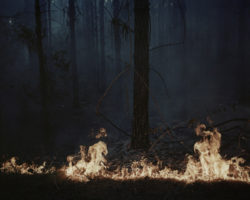
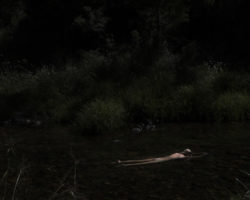
JC: Your first book, Astres Noirs, is a collaboration – or maybe joint book would be a better way to describe it – with Sarker Protick. How did this come about? Books co-authored by two different photographers are so rare – I’m curious to learn more about it.
KK: Actually it was Chose Commune (the publisher) who came up with the thought for the book and who initiated the idea of a more direct dialogue. They’d been following both our practices for a while and saw a link between the works; something in common, which is what made them approach us about publication. Mind you, Protick and I first met at a festival in Germany in 2014 and became close, so any resonance between works we were making probably goes back to that.
JC: How would you describe the result, the book? And I’m still amazed you’d have your work blend with someone else’s so easily. Is that a model you could imagine to do again?
KK: I sort of think of it being not too different from any other thing of togetherness, where everyone offers their part so that collectively those parts can make a new entity. I’m very happy with how the book worked out, and one of my favourite things about it is that a changed light offers a changed reading of it, making it experiential. Looking at it at different times of the same day, or even in a different room, will remarkably alter how the reflective ink will reach your eye. The ‘under’ pages suggest something hidden or out of reach, which works very well too within the overall tone and origin of the images.
It’s interesting – I get asked often about the process, and whether or not it was difficult to give the work over to someone else to make the book. The answer, in my case, is no. I actually enjoyed this immensely. I’m an avid photobook collector and own copies of most of CC’s other publications, all of which I think are very good. I’d been following their work and when they approached, they weren’t just anyone to me. They were someone who knew what they’re doing, with the highest aspirations and attention to detail. Their books are quiet and elegant, and never ruled by design. I knew that I could trust their vision fully, and felt very comfortable in the process. I’m not a designer, so it was great to be working with someone who is an expert. Would I have my work paired with that of another artist again you ask? Well my next book will be a solo-venture. In general, if it felt right- why not?
JC: Can you introduce the work that won the competition, Indefinitely? How did this come about?
KK: Indefinitely grew out of another long-form work of mine called Near, which is a documentation of my family over many years and continents, through cancer and suicide. I started working on Near when I was studying photography in Brisbane, having freshly migrated to Australia from Germany. The work originated from an agony over the distance. Years later, Indefinitely assumes a different format. It’s less direct and more suggestive. Here, I am less interested in representing the family as it is – and describing the distance between us – but rather I want to fill this distance with the world if that makes sense.
The migratory experience is often connoted so negatively; void, hole, empty and lonely and so on. Of course the longing for what you left behind is always present, but there’s more. The world in its entirety presents as the in-between here, profound and insane, and Indefinitely then talks to my view of this world as much as my experience of distance. It creates a space that is both real and imagined. To me, practice is a way of sense making and of being-in-the-world, and making Indefinitely is, not only but also, an attempt to presence absence. It’s storying as a tool to navigate and reconfigure (my) distances. In Austerlitz, W. G. Sebald maintains, “The history of countless places and objects which themselves have no power or memory is never heard, never described or passed on”. The camera enables the giving of story to things, rendering visible.
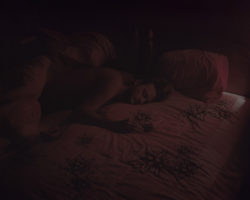
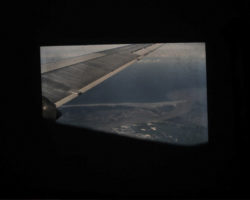
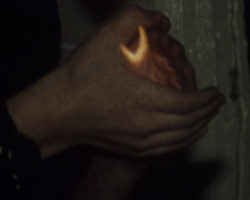
The title of the work plays with this idea that the experience of something has no fixed limit or coordinate. Here, the migratory space as something felt presents as an indefinite time and place. The pictures are made all over the place. There are even pictures of pictures made by my grandmother who had migrated to Colombia, for example the frame of the aeroplane wing above Earth, surrounded by black. In the context of the greater work to me this is a marker picture, layered with meanings – was she arriving or was she departing? What was left behind, and what was waiting? Either way it is a picture about world and Abschied (a great German word for departure or exit which borrows from abgeschieden, meaning distant). I made this picture during a family slide-night, so in this sense it is about the connection between photography and memory. Here, again, is that idea of storying as a tool to navigate distances – her making the picture to hold on to or let go of a story of distance, us viewing the picture to give story or draw closer to something distant, heightened still by the collective reading. Slide nights aren’t really about pictures – they’re all about stories.
JC: Indefinitely (and some of your other projects) offer a strong contrast in terms of very dark photographs versus very bright ones, there is the occasional glaring bright figure in the dark – how do you approach making these pictures? What is it about that stark contrast that attracts you?
KK: If I have to be philosophical about it, perhaps it’s a good reflection of myself. In general, I like using a language of suggestion and a methodology of documentary thinking that allows me to translate the seen into something felt. Emotionality in pictures interests me, and their ability to move. Contrast of course is a device that draws attention to a particular thing within the frame, highlighting it and making it ‘matter’. It can create drama.
Dark works are often the ones I feel most drawn to, maybe because they make me feel that I’m looking at something broken – something in an unfixed state, something uncertain. We don’t normally like looking at broken things. We label them ugly and unworthy. I mean we don’t like sharing wounds and we prefer a pretty landscape (the grand) to the gutter (the trivial). But you know, I think the gutter holds a lot of honesty. I suppose that’s it – the raw throws us up against ourselves. The gutter is a mirror.
Coming back to your question about the bright in the dark – in a practical sense, sometimes I use flash and mostly I work around sunlight hitting reflective surfaces. The whole thing is also intuitive of course, particularly the way one works with light I think. Not everything is planned out or follows a step-by-step guide. Often the world leads me, and to say otherwise would be pretentious. I also don’t work to one single taxonomy of imaging. To me, the narrative has priority, and the language adjusts according to what it is I try to communicate or translate.
JC: In general, where/how do you find the inspiration for your work?
KK: Music and writing. Anouar Brahem, John Zorn, Michel Serres, Rilke, Sebald, Solnit… For example I launched The Crossing earlier this year, another long-form work about Athropocene, ecology and human impact. It draws a lot of inspiration from Serres’ The Natural Contract, a genius book or work of urgent poetry he wrote in 1990, arguing for the need of the extension of the social contract into a natural contract. Twenty-six years on, the book seems more relevant than ever and goes with me everywhere.
Probably the one I’ve read the most is Sartres’s Nausea, but Serres is on his heels. Other than that – proximity. When Chris killed himself and I first started working around this, I’d walk up to the corner store and be completely overcome by something like the way the wind moved through a tree. Through his exit, the presence of worldly things intensified, advocating an immense sense of urgency to me.
So it’s kind of like this; I think that life is a slither of light between the abyss – how lucky and how daunting then, to be a double-witness.
